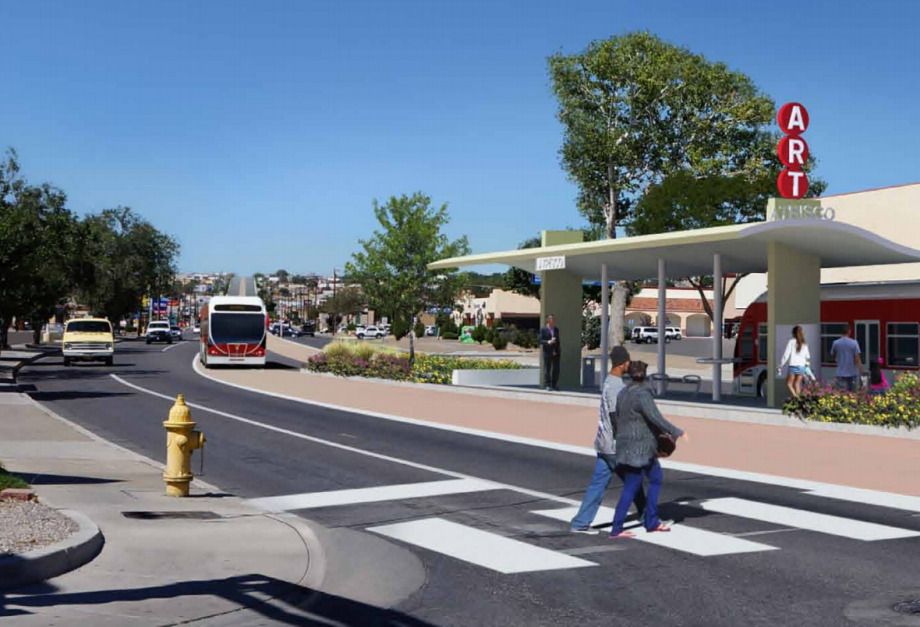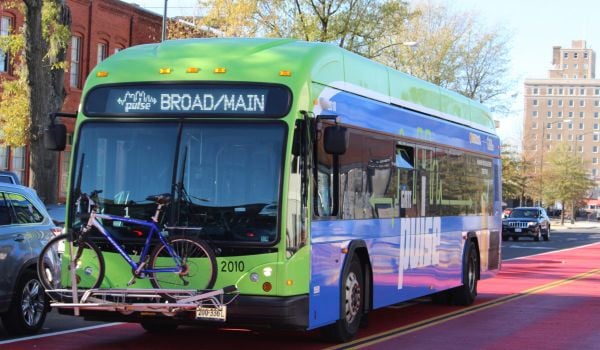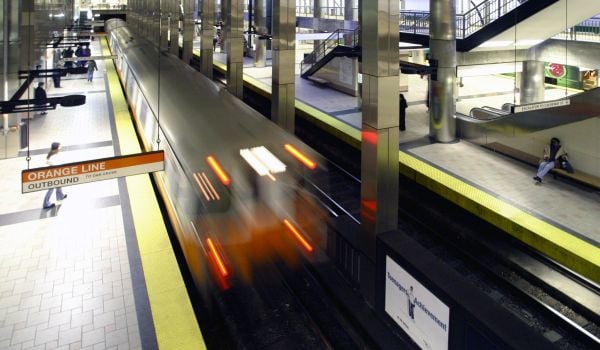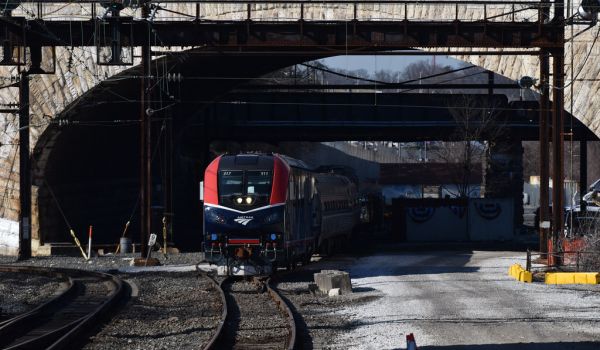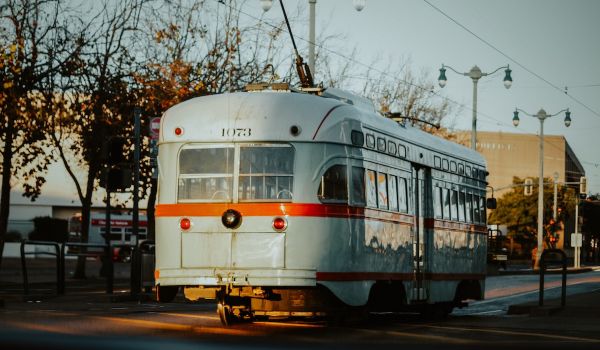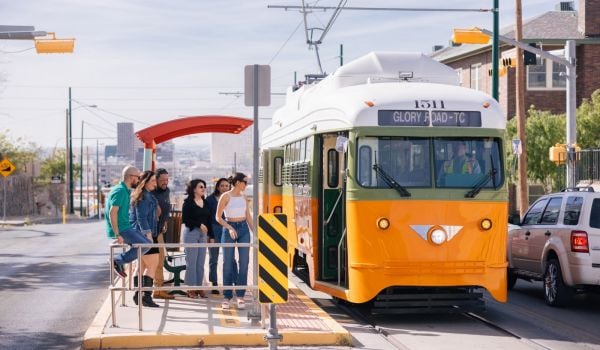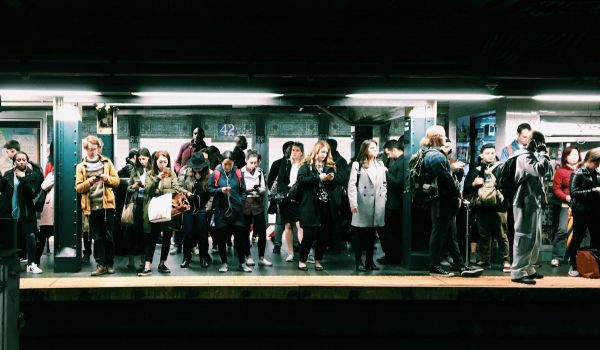From The Grapes of Wrath to On the Road, historic Route 66 has occupied a singular place in the national culture since it was designated in 1926. As home to early roadside service stations, motels and restaurants, it was also a harbinger of the sprawl that would come with interstate highways. While Americana enthusiasts cherish the stretches of open road between Chicago and Los Angeles, sleek buses may soon join vintage cars plying the largest urban stretch of Route 66, on Albuquerque, New Mexico’s Central Avenue.
The major corridor connects many of Albuquerque’s oldest neighborhoods as well as the University of New Mexico to downtown. Along the way, it features plenty of Route 66’s trademark neon signage. Following an aborted attempt to bring a streetcar to Central, ABQ Ride, the city’s transit agency, recently proposed Albuquerque Rapid Transit (ART), essentially a BRT. Central is home to the busiest bus lines in town, responsible for 42 percent of the entire system ridership, and also intersects with the Alvarado Transportation Center downtown, where city buses, Greyhound, Amtrak and a relatively new commuter rail, the Rail Runner Express, all intersect.
But in this Sun Belt city of 550,000, the vast open space, dramatic mountain vistas and endless blue skies buttressing the Rio Grande Valley have contributed to an unhealthy amount of sprawl in a region where water can be scarce. An ambitious new urbanist containment strategy was stymied by the housing crisis. While not as conservative as neighboring Arizona or Texas, political attitudes can be hostile to transit, but are also coming around to its benefits as national trends toward urban living and downtown revitalization have graced Albuquerque.
Much of the debate has played out in the pages of the local paper, where the Albuquerque Journal has run letters to the editor griping about how the city lags behind in mass transit. On October 20th, Randal O’Toole, the “anti-planner,” published an editorial opposing ART on the grounds that ABQ Ride should increase the efficiency of existing buses but not dedicate a whole travel lane to them. O’Toole, however, was writing as a representative of the Cato Institute in Washington, and local advocates from the Greater Albuquerque Chamber of Commerce and the New Mexico chapter of the National Association of Industrial and Office Properties came to ART’s defense last week.
As ABQ Ride gears up for another round of public meetings in anticipation of a fall 2017 opening, Rick DeReyes, the transit agency’s public information officer, provides some perspective. “We get all sorts of people that are concerned or perhaps negatively inclined, but once they understand what’s going on they’re much more positively inclined,” he says. “We’ve been having these public meetings since 2012. We’ve canvassed over 300 businesses on the Central Avenue corridor. They’ve been very supportive, in fact we’ve been surprised as to how supportive the businesses are.”
Whereas the streetcar initiative flopped because state and local government would have footed the bill, the Federal Transit Administration will ideally provide the seed funding for ART through its Small Starts program. Moreover, DeReyes explains, “ART would cost pennies on the dollar in comparison to what a streetcar would.”The cost factor has been a trenchant one in New Mexico, where the Rail Runner Express opened in 2006 to much fanfare as the first inter-city commuter rail in the Intermountain West. It connects metro Albuquerque, population around 1 million, with the state capital, Santa Fe. The city of 70,000 is the oldest state capital in the United States, having been laid out according to the Spanish Law of the Indies town planning statute in 1610. With its preserved Spanish colonial architecture, Santa Fe has a reputation as an artist haven that has made it a destination town and expensive place to live, making the commute from more affordable Albuquerque an attractive prospect for many whose commutes could be sped up by ART. Over half the state’s population lives along the Rail Runner corridor.
The Rail Runner lost its federal subsidy in 2011 without a clear alternative, a planning oversight that has caused the train to struggle financially even after voters taxed themselves to cover $385 million in capital construction costs. While most public transit systems operate at a loss, in the conservative corners of New Mexico, that’s enough justification to call for shutting it down. The libertarian Rio Grande Foundation made a public statement against Rail Runner, and mass transit more generally, in September of last year, prefiguring many of the current debates over ART.
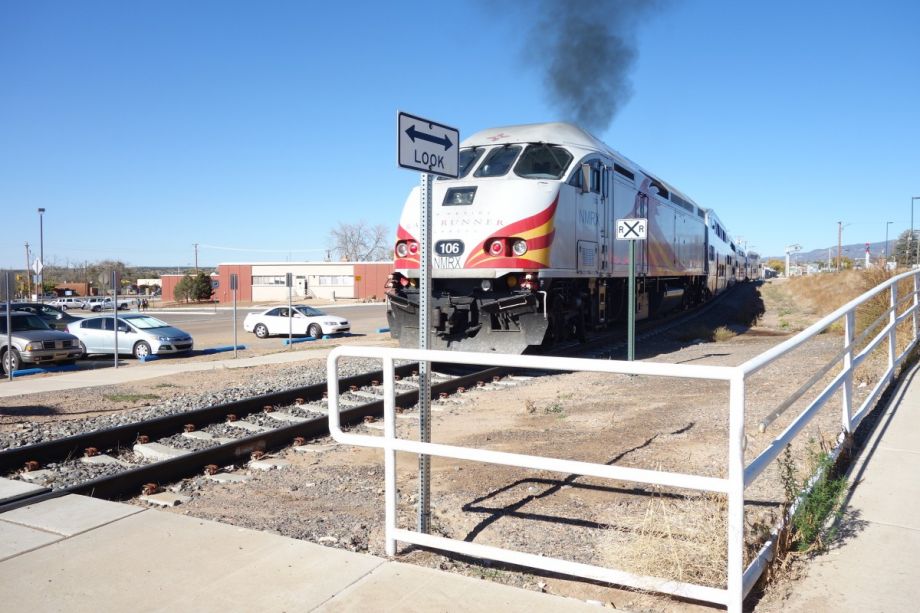
New Mexico’s Rail Runner Express connects metro Albuquerque with the state capital, Santa Fe. (Photo by Greg Scruggs)
On a recent October Saturday, the train was nearly full as passengers daytripped from Albuquerque to Santa Fe, and one of the conductors hopped out to manually flag the crossings in the state capital. These dedicated flaggers have been pitching in at crossings, a manual effort that “has impacted on time performance by an average of 6 to 10 minutes,” according to Doyle, but “has been effective in protecting the crossing while the permanent safety measures are being installed.” Between financial and safety concerns, the Rail Runner is playing a difficult game of catch-up, while the ART hopes to succeed where the Albuquerque streetcar failed. Nothing grows easy in the desert, and as one regular rider told the Santa Fe Reporter in a 2011 feature on the train’s future: “Mass public transit is a new concept in New Mexico.”
The Works is made possible with the support of the Surdna Foundation.

Gregory Scruggs is a Seattle-based independent journalist who writes about solutions for cities. He has covered major international forums on urbanization, climate change, and sustainable development where he has interviewed dozens of mayors and high-ranking officials in order to tell powerful stories about humanity’s urban future. He has reported at street level from more than two dozen countries on solutions to hot-button issues facing cities, from housing to transportation to civic engagement to social equity. In 2017, he won a United Nations Correspondents Association award for his coverage of global urbanization and the UN’s Habitat III summit on the future of cities. He is a member of the American Institute of Certified Planners.




